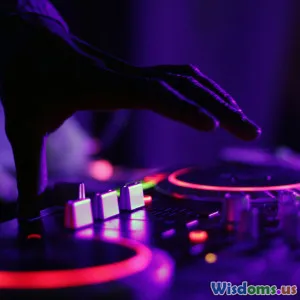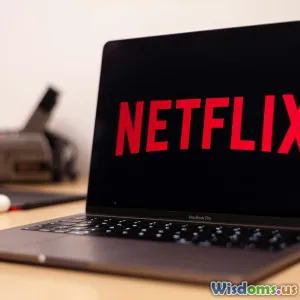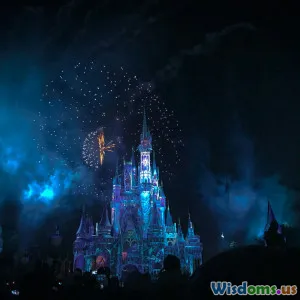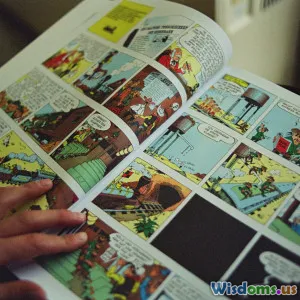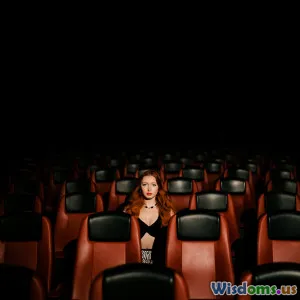
Debunking Common Myths About Movie Soundtrack Production
17 min read Uncover the truth behind common misconceptions about movie soundtrack production and learn how soundtracks are actually created for the big screen. (0 Reviews)
Debunking Common Myths About Movie Soundtrack Production
When we think of movie magic, visuals usually seize our imagination. Yet the soundtracks—the lush orchestral arrangements, haunting synths, or heart-thumping percussions—are the invisible threads weaving emotion and meaning into every scene. Behind every harmonious or pulse-pounding moment is a craftsman's world heavily shaped by myth and misperception. Many assume that movie soundtrack production is simply about plugging in a few melodies or are unaware of the nuanced symphony between composer, director, and technology. Today, we're dismantling some of the most enduring misconceptions, shining a spotlight on the real artistry, collaboration, and technical marvel that make film soundtracks unforgettable.
Myth #1: "Movie Soundtracks Are Created Solely by One Composer or Artist"

The romantic image of a genius composer locked away, scribbling notes and producing a classic score alone, is a staple in public imagination. While solitary creativity is part of the process, the truth is that modern soundtracks are team efforts involving a dazzling array of talent.
Reality Check:
- Multiple Roles, One Vision: A film's score is often the result of complex collaboration. Take Hans Zimmer, whose iconic scores for films like Inception and Interstellar were co-composed and involved large teams of arrangers, music editors, orchestrators, programmers, and instrumentalists.
- Additional Music Contributors: High-profile films may credit a lead composer, but teams such as Remote Control Productions (Zimmer's group) often work in tandem to develop themes, moods, and textures. This allows the score to be both coherent and rich in detail.
- Ghostwriters and Orchestrators: 'Ghostwriting'—composers writing under another's name—happens more than audiences realize. For example, while John Williams is renowned for his solo accomplishments, his film scores for Star Wars or Indiana Jones relied on orchestrators like Herbert W. Spencer to translate piano sketches into full orchestral scores.
Insight: The intricate division of labor mirrors the filmmaking process itself, where every hand shapes the final masterpiece.
Myth #2: "Soundtracks Are Just About Creating Emotional Background Music"

To many viewers, a soundtrack simply stirs feeling—cue swelling strings for love, synth stabs for suspense. Yes, music elicits emotion, but its function in storytelling is more sophisticated.
Analysis & Examples:
- Narrative Foreshadowing: Alfred Hitchcock’s Psycho (1960) used Bernard Herrmann’s jarring strings to clue in the audience to narrative shocks before they unfolded visually.
- Leitmotifs & Thematic Storytelling: Leitmotifs—recurring musical phrases associated with characters or ideas—anchor films like The Lord of the Rings. Howard Shore’s motifs provide subtle cues on relationships and character development far beyond simple mood-setting.
- Diegetic vs. Non-Diegetic Music: Many films artfully interweave on-screen (diegetic) and off-screen (non-diegetic) music for storytelling impact, as seen in Baby Driver where the protagonist’s life is meticulously synced to his playlist, making the music almost a character itself.
- Strategic Silence: Sometimes, it’s the absence of music that sharpens tension—think of the unscored moments in No Country for Old Men.
Practical Tip: If you're a budding filmmaker, collaborate early with your composer to explore how music can foreshadow, reinforce or subvert the narrative—and not just underscore action.
Myth #3: "It's All Real Instruments—Digital Sounds Aren't Used or Respected"

Blockbusters like Star Wars conjure up visions of expansive orchestras. Yet in today's industry, digital instruments—or "sample libraries"—play a crucial role, often lending worlds of sound unreachable by traditional means.
How Digital Tech Shapes Soundtracks:
- Sample Libraries: Top composers use vast libraries with thousands of high-fidelity recordings of real instruments. For example, Spitfire Audio and EastWest Quantum Leap are industry go-tos. Without these, a single studio session could cost tens of thousands of dollars.
- Blended Palettes: Most modern scores feature both real and synthesized instruments. The epic scope of Tron: Legacy (composed by Daft Punk) was achieved via a blend of live orchestra and electronic manipulation, creating its futuristic timbre.
- Access and Innovation: Digital tools allow experimental sounds not possible with traditional setups. In Gravity, composer Steven Price manipulated sounds in post-production to reflect the cold, oxygen-less environment of space.
- Filling Out Sound Worlds: Low-budget filmmakers tap into these tools to achieve a professional sound without a Hollywood budget. Multi-instrumentalist Michael Giacchino often starts with demos entirely in digital before orchestrating for live recording, a strategy echoed throughout the industry.
Takeaway: Dismissing digital tech as lesser is outdated. Instead, the modern composer is as much a savvy producer and sound engineer as a musician.
Myth #4: "Composers Watch the Final Film and Then Add Music"

The process of scoring is not a tacked-on afterthought. Music is often interlaced with film production relatively early and through careful choreography with editorial and directorial vision.
How the Score Integrates With Production:
- Spotting Sessions: Once a rough cut is available, composer and director (plus music supervisor and editor) sit together in a 'spotting session' to map out where and how music will be used. This important storytelling process shapes both music and edit.
- Temp Tracks: To set mood and pacing during editing, temporary music (temp tracks) are often used. Sometimes these temp tracks influence the direction of the actual score, a phenomenon called "temp love" that can sometimes frustrate composers aiming for originality. David Arnold, who scored multiple James Bond films, has described the pain—and inspiration—of working under temp track influence.
- Composing to Script: Some auteurs, notably Quentin Tarantino, choose music before shooting, integrating tracks so deeply into the film that scenes and cuts align perfectly with the chosen song, as with the ear-cutting scene in Reservoir Dogs.
- Ongoing Revisions: Scoring often leads to re-edits when music brings unexpected energy, altering how scenes play. Lord of the Rings and The Social Network subtly adjusted edits to fit the emotional shape provided by Howard Shore's and Trent Reznor/Atticus Ross's award-winning music, respectively.
In Practice: Early and ongoing collaboration between departments is key; the soundtrack is rarely just a post-production topping.
Myth #5: "Writing a Movie Score Is Purely Artistic—Business Concerns Don’t Intervene"

We like to think of composers conjuring masterpieces in isolation, free from worldly constraints. The reality is rooted in dealmaking, deadlines, and economic choices as much as artistic freedom.
The Business Side of Film Scoring:
- Budgetary Limits: Not every director can afford a 90-piece orchestra. Films like The Blair Witch Project or indie releases rely heavily on digitally produced, cost-efficient scores. Even blockbusters sometimes economize (e.g., reusing cues, licensing previously composed music).
- Contracts and Deadlines: Composers face tight deadlines—sometimes only a few weeks to deliver a full score. This can determine the size and scope of the project. Legendary composer Jerry Goldsmith scored Chinatown in just 10 days, delivering one of cinema’s definitive soundscapes.
- Producer Input: Studios and producers often request changes for commercial or branding purposes. A powerful track may be replaced for marketing tie-ins, such as the wave of pop song inclusions in big-budget films. Think of Suicide Squad—its soundtrack reshaped late in the editing process to mimic successful 'music-driven' blockbusters.
- Music Licensing: Scores must negotiate legal terrain. Failing to secure rights can lead to cuts or forced last-minute changes, as was the case for A Knight’s Tale, which made the bold choice to mix classic rock with period drama after facing music rights complexities.
Advice for Newcomers: Be prepared not only to create, but negotiate, budget, and pivot your vision.
Myth #6: "Blockbusters and Indie Films Approach Scores the Same Way"

We often lump film scoring under one umbrella, but the realities of big and small-budget productions couldn't be more different.
Blockbuster vs. Indie:
- Access and Scale: Blockbusters like Avengers: Endgame deploy massive orchestras, top-tier mixing engineers, and star composers (Alan Silvestri, in that case). Meanwhile, indie films may have a composer who works out of a bedroom studio, relying on plugins and sample libraries.
- Creative Constraints Lead to Innovation: Smaller budgets force indies to innovate. For example, It Follows composer Disasterpeace (Rich Vreeland) used atmospheric, synth-driven tracks that became a defining feature of the film’s unsettling atmosphere—achievable without traditional orchestration.
- Timeframes: Indies might have more extended post-production phases, where a composer can experiment. Conversely, blockbusters work to punishing, rigid timelines, often limiting bold experimentation after principal photography wraps.
- Distribution and Revenue: Licensing songs for big-budget movies can cost millions, while indies might turn to up-and-coming bands, either for free or on spec, as with Juno and its now-iconic, modestly budgeted soundtrack.
Key Learning: While spectacle grabs headlines, much of the creative spirit behind the best soundtracks emerges from constraints, not excess.
Myth #7: "Soundtracks Are Only Instrumental Orchestral Pieces"

If you think a movie soundtrack equals symphonic music, you’re in for a surprise. The term ‘soundtrack’ encompasses a marvelously diverse landscape.
The Breadth of Musical Worlds On Screen:
- Song-Driven Scores: From The Graduate’s Simon & Garfunkel tunes to the hip-hop brilliance of Spider-Man: Into the Spider-Verse, films have long used pop, rock, folk, and hip-hop to underscore narrative and vibe.
- World and Ethnic Music: Slumdog Millionaire exploded with South Asian rhythms, propelled by A.R. Rahman's versatile sensibilities, which added depth and authenticity.
- Eclectic Pairings: Tarantino famously brings surf rock into Pulp Fiction, spaghetti western cues into Kill Bill, and ‘Stuck in the Middle With You’ to horror comedy. These bold choices help define his signature style.
- Hybridization: Soundtracks today often blend genres or period styles—think of Black Panther’s mix of traditional African percussion with modern beats, curated by Ludwig Göransson and production input from Kendrick Lamar.
Reflection: If you assume a soundtrack is mere orchestral wallpaper, you’re discounting the vast, evolving tapestry of what music achieves in film.
Myth #8: "Great Scores Don’t Require a Deep Understanding of the Film Itself"

Some believe that a gifted composer can just feel their way into a fitting score. In actuality, intimacy with every aspect of the film is crucial.
Critical Insights for Music That Resonates:
- Script Analysis: Composers frequently dissect scripts to uncover subtext; an approach Alexander Desplat championed for The Shape of Water.
- Collaborative Conversations: Deep dialogues with the director, cinematographer, and editors reveal visual motifs, color palettes, and internal character arcs that should be echoed in music.
- Motif Layering: A nuanced approach allows themes to pivot as the story evolves—such as the gradual darkening of themes in Harry Potter as the saga matures.
- Cultural/Historical Context: Scores set within specific periods or cultures demand in-depth research. For instance, Nicholas Britell’s work for If Beale Street Could Talk involved studying jazz evolutions and historical soundscapes.
Actionable Tip: Invest time in script-reading, scene breakdowns, and creative discussions early in your process. The best scores don’t just accompany the image—they inhabit it.
Debunking the Stereotypes: How Soundtrack Professionals Redefine the Art

Movie soundtrack production is a blend of art and craft, solitary inspiration and energetic teamwork. Every myth debunked reveals another layer of technical innovation, business savvy, and a relentless devotion to storytelling. Next time you lose yourself in a perfectly scored cinematic moment, listen past the myths: That's not just music—it's the heart of film, shaped by countless hands and bold, contemporary minds.
Rate the Post
User Reviews
Other posts in Movie & TV Show Soundtracks
Popular Posts










